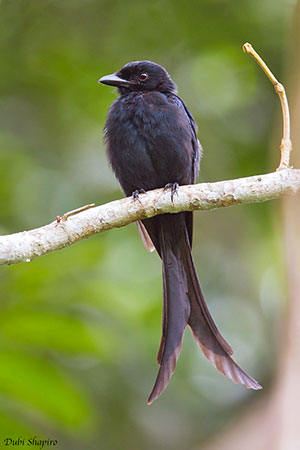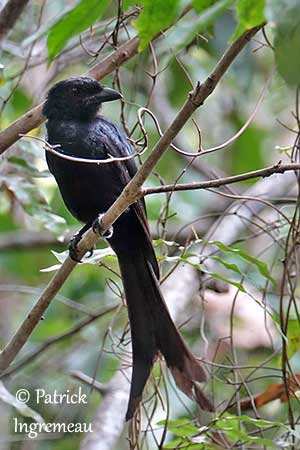
The Mayotte Drongo is resident.
This species has swift flight. While hunting, it performs aerial acrobatics to catch insects in the air and between patches of vegetation.
REPRODUCTION OF THIS SPECIES:
The breeding season takes place between September and February, and coincides with the rainy season that provides numerous insects.
Both adults build the nest, a rounded cup-shaped structure made with woven vegetal fibres. It is placed in tree, on fork of horizontal branch above an open area. Several tree species are used for nesting.
The female lays 1-3 pinkish-cream eggs with darker markings. A replacement clutch is laid in a new nest if the first is lost. Both adults incubate during about three weeks. The young fledge 17-22 days after hatching, and still depend on parents for food during at least 4-7 weeks. They remain in family group until the beginning of the next breeding season. Only one brood is laid per season.
They are vulnerable to predators such as raptors, owls, lemurs and other introduced species, but they attack them if they approach too close to the nest.
PROTECTION / THREATS / STATUS:
The Mayotte Drongo has very restricted range. It is threatened by habitat destruction caused by deforestation for agriculture expansion. Introduction of nest predators involves low breeding success. The species may occur in some reserves, but these areas are not really protected under French law.
The population was roughly estimated at 7,500 individuals in 2002-2004. In spite of persisting in degraded habitats, the species is affected by forest clearance and the population is suspected to be declining.
The Mayotte Drongo is currently classified as Vulnerable.
Fr: Drongo de Mayotte
Ang: Mayotte Drongo
All: Mayottedrongo
Esp: Drongo de la Mayotte
Ita: Drongo di Mayotte
Nd: Mayottedrongo
Sd: mayottedrongo
Photographers:
Patrick Ingremeau
TAMANDUA
Dubi Shapiro
Dubi Shapiro Photo Galleries & Dubi Shapiro's Pictures on IBC
Text by Nicole Bouglouan
Sources:
HANDBOOK OF THE BIRDS OF THE WORLD Vol 14 by Josep del Hoyo-Andrew Elliot-David Christie - Lynx Edicions – ISBN: 9788496553507
OISEAUX des ÎLES DE L’OCÉAN INDIEN De Ian Sinclair – Editeur : Penguin Random House South Africa, 2013 – ISBN : 1775840727, 9781775840725 - 263 pages
CREAGUS – Don Roberson - Dicruridae
Drongos - From Wikipedia, the free encyclopedia
THE AVIANWEB - Beauty of Birds (Sibylle Faye)
Home page
Page Passeriformes Order
Mayotte Drongo
Dicrurus waldenii
Passeriformes Order – Dicruridae Family
INTRODUCTION:
The Mayotte Drongo is endemic to Mayotte Island in the Comoros Archipelago. It frequents humid natural forests above 200 metres and the coastal areas at lower elevation. It feeds mainly on insects caught in the air or on the ground. It breeds during the rainy season which is related to food availability.
The Mayotte Drongo is threatened by habitat destruction through deforestation, and by introduced predators. The species is currently classified as Vulnerable.
DESCRIPTION OF THE BIRD:
Biometrics:
Length: 35-38 cm, with the tail: 18-20 cm
The Mayotte Drongo has glossy black plumage overall with dull bluish gloss. The long tail has ten feathers and is deeply forked. It is described as “lyre-shaped”, with the second half of the outer rectrices curving outwards.
The strong bill is black, broad and deep at base. It is 35 millimetres long, with curved culmen and hooked tip. The eyes are red. Legs and feet are black.

The juvenile is mostly brownish-black and duller. The tail is shorter and less forked. The underparts appear paler with some indistinct white tips on both undertail and underwing-coverts.
RANGE:
The Mayotte Drongo is endemic to Mayotte Island in SE Comoros Archipelago. It is present only on Grande Terre.
HABITAT:
The Mayotte Drongo is found above 200 metres of elevation around the four mountains where it frequents large patches of humid natural forest in N and C of the island. It can be seen along the west coast at lower elevation, and also in mangroves.
CALLS AND SONGS: SOUNDS BY XENO-CANTO
The Mayotte Drongo gives a variety of calls including a repeated, loud “tyok” and a throaty “choo-kroo-kreech”, the latter usually near the nest. Numerous types of calls can be heard because this species has a large repertoire of sounds.
The Mayotte Drongo performs beautiful duets during the breeding season within the territory, and mainly near the nest-site. The song is complex and includes various chirps and squeaks, loud whistles and harsh nasal notes alternated with creaky squawks and grinding sounds.
But at close range, we can hear a soft, continuing whistling chatter. This species is also known for its ability to mimic other bird calls.
BEHAVIOUR IN THE WILD:
The Mayotte Drongo feeds primarily on various insect species such as Cicadidae, Lepidopterans, Hymenopterans, Dipterans, Orthopterans and Coleopterans. It also takes spiders and millipedes. The cicadas are the main food during the breeding season.
Nothing is known about some invertebrates such as lizards and chameleons as part of the diet.
The Mayotte Drongo usually hunts from perch and performs sallies, flycatching, hovering, gliding down and zigzag flights through the vegetation. It also catches insects on the ground, but mostly in flight and from tree trunks and vegetation.
During the breeding season, both mates display together and perform duets. Both birds sing while bobbing head and body up and down in rapidly alternating turn. They are facing and almost touching each other, while performing a strong vocal and dancing display.
The Mayotte Drongo is highly territorial. They are monogamous with strong pair-bonds. They aggressively defend the area around the nest from predators and other drongos.
